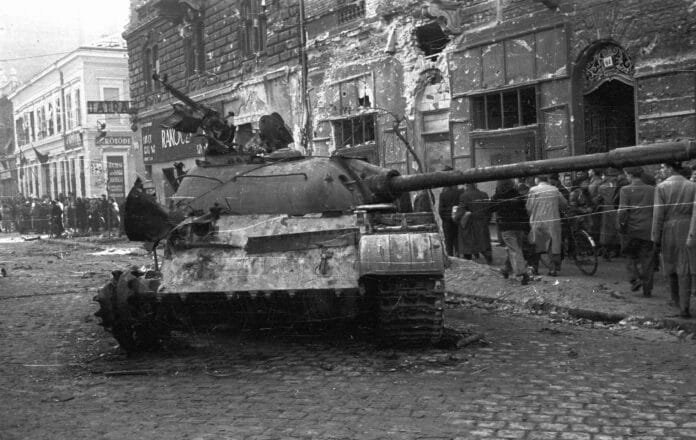
Begivenhederne i Ungarn, der tilspidsedes i oktober-november 1956, handlede ikke kun om befrielsen fra russisk dominans af landets økonomiske og politiske liv.
Gennem organiseringen af arbejderråd blev indholdet revolutionært, og bragte diskussionen af socialismens grundlæggende indhold tilbage på dagsordenen.
Indhold / Contents
- Forord
- Foreword
- Artikler og leksikale mv. (på dansk)
- Artiklar och böcker (på Svensk)
- Books, sites, etc. (in English)
- Articles (in English)
Forord
Begivenhederne i Ungarn, der tilspidsedes i oktober-november 1956, handlede ikke kun om befrielsen fra russisk dominans af landets økonomiske og politiske liv.
Gennem organiseringen af arbejderråd blev indholdet revolutionært, og bragte diskussionen af socialismens grundlæggende indhold tilbage på dagsordenen.
Og dermed blev der sat spørgsmålstegn ved stalinismens pervertering af socialismen siden 1920’erne.
Én af konsekvenserne af Ungarn 1956 blev bruddet med det russiske monopol på venstrefløjens opposition til socialdemokratierne, og opkomsten af nye veje for den internationale venstrefløj i de efterfølgende 20 år.
Og set i det historiske bakspejl, blev Ungarn 56 også begyndelsen til enden for regimer, der var det stik modsatte af socialistiske.
Disse link er samlet i det perspektiv.
Jørgen Lund &
Bjarne A. Frandsen
November 2006. Revideret juni 2021.
Foreword
The events in Hungary in October-November 1956, were not just about the liberation of economical and political life of the country from the Russian domination.
By organising workers councils the contents of the events became revolutionary, and put the fundamental questions of socialism back on the agenda.
The development of the workers movement in Hungary was questioning the Stalinist perverting of the idea of Socialism, that has developed since the defeat in the 1920s.
Hungary 1956 was a break up of the Russian monopoly of being the left opposition to Western Social Democracies, and opened up new roads for the international Left for the two decades ahead.
In hindsight it is clear that Hungary 1956 became the beginning of the end of an era of regimes, that claimed Socialism, but in reality was the opposite.
These collection of links are compiled from that perspective.
Jørgen Lund &
Bjarne A. Frandsen
November 2006. Revised June 2021.
Artikler og leksikale mv.
Den Store Danske
Gnisten
Bjørn Østby: Ungarn 1956 – et glimt av arbeidermakt (nr.8, november 2006)
“Den ungarske revolusjonen som startet i oktober for 50 år siden var det mest radikale og organiserte sosiale opprøret Øst-Europa hadde sett siden den russiske revolusjonen i 1917.”
Historie-online.dk
Ungarnsopstanden 1956. Af Lone Alstrup (2007). Anmeldelse af Morten Bendix Andersen: Ungarnsopstanden 1956 – i dansk erindringshistorisk perspektiv (Schønbergske Forlag, 2007, 214 sider)
“Bogen er en grundig indføring i den historisk-politiske fortolkning af en krise, der i Danmark fik en markant mediebevågenhed og stor støtte fra befolkningen.”
Ungarn 1956. Af Erik Ingemann Sørensen (2006). Anmeldelse af Victor Sebestyen: Ungarn 1956 (Borgen, 2006, 361 sider)
“… denne bog er først og fremmest et stærkt følelsespræget partsindlæg skrevet af en journalist. Ikke af en historiker.”
Leksikon for det 21. århundrede
Politisk Revy
Tema: 1956: den kommunistiske bevægelses kriseår (nr.292, 23. juli 1976, 32 sider)
Af indholdet:
Ungarn 1956 (s.13-19)
“Den største artikel i denne del er en gennemgang af selve opstanden og dens forløb. Men der er også artikler om bagrunden for opstanden: Ungarns politiske historie siden rådsrevolutionen i 1919 og beretningen om kommunisternes vej til magten ved folkedemokratiets dannelse efter 2. verdenkrig. Desuden en artikel om den opstand i Polen 1956, der førte til en ‘demokratisering’ under Gomulkas ledelse.”
Ungarn i Danmark (s.20-24)
“I Danmark blev partibladet Land og Folk ikke med urette en taknemmelig skydeskive for antikommunismen. Den opgave på en gang at forsvare Sovjetunionen, afstaliniseringen og indgrebet mod Ungarnopstanden … var uløselig … Det dokumenters i den første artikel – som samtidig handler om den interne reaktion i partiet. De øvrige artikler handler om socialdemokraternes og de borgerlige ideologers brug af Ungarnopstanden til hetz mod kommunisme og socialisme i almindelighed.” **
Af det øvrige indhold afsnit om: Den 20. partikongres (s.4-12) + Bevægelsens opsplitning (s.25-31).
** Se også: Partidiskussionen: Foran den 19. (ekstraordinære) kongres: Ungarn – og vort parti (Tillæg til Land og Folk, fredag den 4. januar 1957; faksimile online på Det Kongelige Biblioteks Småtrykssamling, partiprogrammer).
Kongressen blev afholdt 18.-20. januar 1957, og blev et “foreløbigt kompromis mellem to uforenelige synspunkter.” (Steen Bille Larsen: Kommunisterne og arbejderklassen 1945-1975″, Tiderne skifter, 1977, s.102).
Revolution
Ben Glinieck: Revolutionen i Ungarn: 60 år efter (4. januar 2017)
Denne artikel blev oprindelig bragt hos Socialist Appeal og i Revolution nr. 25, december-januar 2016-17: “I modsætning til den stalinistiske bagvaskelse på det tidspunkt var det ikke en bevægelse for genindførelsel af kapitalismen.”
Socialististisk Arbejderavis
Ungarn 1956: Genfødslen af socialisme fra neden (nr. 354, 20. oktober 2016; kun online)
“I anledning af 60-året for den ungarske revolution beskriver Tomáš Tengely-Evans, hvordan arbejdere og studerende kæmpede for magten – og rystede det regime, der påstod at repræsentere dem.”
Peter Kjær: Da arbejdermagt rystede Østeuropa: Ungarn 1956 (nr. 261, oktober 2006)
“For 40 år siden, d. 23. oktober 1956, startede Ungarns arbejdere en af det tyvende århundredes største revolutionære opstande. Nogen påstår, at det var et oprør mod socialismen. Men i virkeligheden indeholdt oprøret alle elementerne fra en ægte socialistisk revolution, og det var rettet mod et regime, der var det absolutte modsatte af socialisme.”
VS Bulletin
Karsten Ditlevsen: Kampen for demokrati, uafhængighed og selvforvaltning: Ungarn 1956 (nr.240, oktober 1986, s.24-29)
“Denne artikel søger … at besvare spørgsmålene: Hvad kæmpede ungarerne egentlig for? Hvem var opstandens drivende kræfter? Hvad var dens sociale og politiske indhold?” Artiklen er online på Modkraft.dk: Ungarn 1956: Demokrati, uafhængighed og selvforvaltning (1. juni 2005).
Karsten Ditlevsen: Stalinismens arvninger: Ungarn 1956 (nr.241, december 1986, s.24-29)
“Ungarns-opstanden i 1956 var en kontrarevolutionær opstand … Således lyder stalinisternes dom over begivenhederne – en noget anden historie end den, man kunne læse i sidste nummer. Karsten Ditlevsen går i clinch med historieforfalskningen.” Artiklen er online på Modkraft.dk: Ungarn 1956: En kontrarevolutionær opstand? (17. juni 2005).
Wikipedia.dk
Artiklar och Böcker (på svensk)
Marxistarkiv.se
- Artiklar om Ungern
- Böcker om utvecklingen i Ungern (av Andy Anderson, Peter Fryer, Sture Källberg och Pierre Broué)
Ungern 56: Den beväpnade sanningen (pdf)
Av Andy Anderson (Arbetarpres, 1975, 91 sider; online på Arbetarmakt.se)
“[Bogen] utgavs för första gången 1964 av Solidarity i England. En
andra engelsk upplaga trycktes 1968 … Den svenska översättningen följer Solidaritys utgåva från 1968.”
Books, sites, etc.
Hungarian Tragedy
By Peter Fryer (London, Dennis Dobson, 1956, 96 pages; online at Marxists Internet Archive)
“This little book was written in a week. Or rather, it poured itself on the page white-hot. It bears the marks of haste, emotion and disillusionment. It is not free from naivetes and purple passages … Yet, for all its faults, this book does tell the truth about the Hungarian uprising of 1956. To tell that truth was, I thought, my duty to the Hungarian workers who had fought and died so selflessly and whose gallant struggle, so brutally suppressed, I had witnessed. For telling the truth in this book I was expelled from the Communist Party.”
Se om Peter Fryer på tidslinjen 31. oktober 2006
Revolution and Counter-Revolution in Hungary
By Hugo Dewar and Daniel Norman (London, Socialist Union of Central-Eastern Europe, 1957, 96 pages; online at Marxists Internet Archive)
Hungary ’56
By Andy Anderson (London, Solidarity, 1964, 48 pages; online at Libcom.org)
“Andy Anderson’s pamphlet, written in 1964 and published by Solidarity Group is invaluable as a guide to the events of the Hungarian uprising of 1956. The demands for economic and political self-management were common to many revolutions of the past, but were unique in that they occurred in the context of the ‘Communist’ USSR, and after Stalin’s regime had ended.” See also Swedish edition: Ungern 56 – Den beväpnade sanningen (pdf) (Arbetarpres, 1975, 91 sider).
Libcom.org
Hungary 1956: reading guide
“Libcom.org’s reading guide to the 1956 Hungarian uprising against the Communist dictatorship which saw a general strike declared and workers’ councils spring up across the country.”
1956 – Oral History Archive
“At the centre of the OHA’s collecting work stand the decisive figures among the participants, victims and shapers of the revolution.”
1956: The Hungarian Revolution
“An account of the workers uprising in Hungary. Originally published by Scorcher Publications in the 1980s as No.1 in a series of Council Communist Pamphlets.”
Spartacus Educational
Wikipedia, the free encyclopedia
- Hungarian Revolution of 1956
Contents: Prelude – Revolution – Aftermath – References – Further reading – External links.
A World to Win
Theme: Hungary 1956 – 50th anniversary special (2006; scroll down)
“A World to Win is proud to commemorate the revolutionary heroism of Hungarian workers and students by publishing a specially written article by website editor Paul Feldman about the events that shook the world in 1956. In addition, we are reproducing contemporary analysis and links to photographs, films and reporting.” With Resolutions and statements.
Articles
Counterfire
1956: Hungary’s lost revolution. By Sean Ledwith (October 19, 2016)
“The 21st century anti-capitalist movement owes a debt to the heroic and inspiring working-class uprisings in Hungary 60 years ago.”
1956: Hungary and Suez. Part 96 in Neil Faulkner: A Marxist History of the World (7 October 2012)
“1956 was a year of war, revolution, and disillusionment – a year after which nothing could ever be quite the same again.”
In Defence of Marxism
Julianna Grant: Hungarian revolution 1956, forty years on (7 October 2002)
“We are republishing this article on the 1956 Hungarian revolution, first published on the 40th anniversary in Socialist Appeal.”
International Socialism
G.M. Tamás: Hungary 1956: a socialist revolution (Issue 152, Autumn 2016, p.111-116)
“Social discontent and moral revulsion characterised this first episode of 1956. It developed into a fully fledged revolutionary movement only after the attempts to repress it.”
Mike Haynes: Hungary: Workers’ councils against Russian tanks (Issue 112, Autumn 2006, p.81-106)
“The Hungarian Revolution of 1956 was an authentic working class revolution. Other factors were involved; revolutions are complex things. But the driving forces of the Hungarian Revolution were the efforts of the workers. First they established organs of popular power. Then they fought to extend them to defend Hungary against the invading Soviet forces that eventually allowed the puppet government of János Kádár to crush the revolt.”
Balász Nagy: The Central Workers’ Council: Budapest 1956 (Issue 18, Autumn 1964)
“Eight years ago, on 23 October 1956, the Hungarian revolution, the most important event in international working-class history since the Russian revolution of 1917, began. In honour of the eighth anniversary we are printing a shortened version of Balázs Nagy’s account of the formation of the Central Workers’ Council of Greater Budapest. This first appeared in French, in the volume Études sur la Révolution Hongroise, edited by the Imre Nagy Institute for Political Research, Brussels, in 1961.”
International Socialist Review
Dennis Kosuth: Revolution in a ‘workers’ state’: Hungary 1956 (Issue 51, January–February 2007)
“Every revolutionary socialist should know about Hungary in 1956, not only to refute the distortions from the Left and the Right, but to learn from and be inspired by the magnificent struggle of ordinary people against a horribly repressive and exploitative regime – a regime that disguised itself with the rhetoric of socialism, but in reality had nothing in common with it, a regime diametrically opposed to genuine workers’ democracy.”
International Viewpoint
Phil Hearse: The crushing of the Hungarian Revolution (Issue 382, October 2006)
“At dawn on November 4, Russian tanks, which had withdrawn from Budapest after the first round of fighting, returned. Six thousand guns opened fire on the city, raining phosphorous shells on combatants and non-combatants alike. Knowing that the attack was coming, ‘reform Communist’ Prime Minister Imre Nagy and his closest colleagues took refuge in the Yugoslav embassy. The assault took place a few hours after French, British and Israeli troops invaded Egypt, starting the Suez crisis. Together, the two events had a massive effect on the development of the left internationally.”
London Review of Books
Eric Hobsbawm: Could it have been different? (Vol.28, No.22, 16 November 2006). Review article.
“New documentation has transformed the history of the Hungarian October since the fall of Communism opened the Hungarian and many of the Russian archives and Freedom of Information legislation eased access to state papers in the US. All but one of the books discussed here are written by Hungarians old enough to have been participants or contemporary observers, or at least infants, in 1956.”
Debate/Letters (scroll down):
- From Ian Birchall (Vol.28, No.23, 30 November 2006)
- From Sandor Vaci (Vol.28, No.24, 14 December 2006)
- From Eric Hobsbawm (Vol.29, No.1, 4 January 2007)
Marxists Internet Archive
Glossary of Events: Hungarian Uprising (1956)
“The Hungarian Uprising began on 23 October 1956 when the working class took on and defeated the police and installed a new government, lasting 18 days before being crushed by Soviet tanks.”
Tony Cliff: Background to Hungary (Socialist Review, No.13, July 1958)
“Imre Nagy is not the first, alas, probably not the last of the Communist Party leaders to be murdered by the Stalinist leaders … Nagy and his associates could not, from prison, have constituted a danger to the Kremlin rulers. Why then were they murdered? The immediate and obvious answer is: By accusing the Titoist, Nagy, of being a ‘traitor’ and ‘imperialist agent’, Tito himself is being accused.”
Ted Grant: Hungary and the crisis in the Communist Party (November 1956)
“This was written as an open letter to members of the Communist Party of Great Britain, urging them to reconsider their support for the pro-Moscow leadership in the light of events in Hungary.”
The New Reasoner
Peter Fryer: Hungary in restrospect (pdf) (No.1, Summer 1957). Review article.
“The extremes meet. The ultra-Right and pseudo-Left sometimes find a surprising amount of common ground. A striking example of this is their assessment of the fundamental character of the events in Hungary last October and November. To both the reactionaries of the Right and the reactionaries of the Left – the Stalinists – these events were essentially counter-revolutionary.”
Dora Scarlett: A bureau in Hungary (pdf) (No.7, Winter 1958-59)
“The author of this article worked for four years for the Foreign Language Department of Radio Budapest. She was assigned to this work by the British Communist Party, but instructed to preserve complete secrecy … By taking examples from the daily life and routines of one of the great bureaux in the ‘new democracies’, she gives a ‘worm’s eye view’ of life under the Rakosi regime.”
Malcolm MacEwen: Imre Nagy (pdf) (No.7, Winter 1958-59)
“The purpose of this review is to examine the charges made against Imre Nagy by the Hungarian Government, and by the entire Communist propagandist apparatus. The Communist Party leaders hoped by the trial and execution of Nagy not only to frighten revisionists and would-be revisionists (whatever that word may mean), into silence and inactivity, but also to prove that revisionism was bound to end in alliance with imperialism and counter-revolution.”
Tibor Meray: Imre Nagy, Communist (pdf) (No.9, Summer 1959)
“On the occasion of the first anniversary of the execution of Imre Nagy, we publish this tribute to his memory by an old friend and fellow-Communist, Tibor Meray – a Hungarian writer and political journalist now living in exile in Paris.”
RS21: Revolutionary Socialism in the 21st Century
How memories of Soviet repression turn Eastern Europe against the left (November 14, 2017)
“Reflecting on the recent anniversary of the 1956 Hungarian Uprising, Hanna Gal offers some personal thoughts on the anti-communist political culture of Eastern Europe, and on how to bridge the divide between Eastern European workers and Western Marxists.”
Budapest 1956: The Central Workers’ Council (October 23, 2016)
“The Hungarian uprising against Stalinist domination began sixty years ago, on 23 October 1956. Here we reprint a description of those days written by Hungarian Marxist Balázs Nagy [in 1961].”
Socialism Today
Clare Doyle: Hungary ’56: The truth behind the tragedy (Issue 105, Nov. 2006)
“It is 50 years since the workers and youth of Hungary rose up against the totalitarian Stalinist regime. It was a heroic attempt to overthrow the dictatorship and strive for workers’ democracy, ultimately crushed by the military might of the Soviet Union.” With Chronology.
Socialist Appeal
Ben Gliniecki: The Hungarian Revolution: 60 years on (24 October 2016)
“Contrary to Stalinist slanders at the time, this was never a movement for the restoration of capitalism. It was an attempt by working class Hungarians to take control over their own lives and establish a healthy socialist society.”
Socialist Register
Bill Lomax: Twenty-five years after 1956: The heritage of the Hungarian revolution (1982, p.79-104)
“Bill Lomax’s study Hungary 1956 (London, Allison & Busby, 1976) was republished in Hungarian samizdat in 1981 on the 25th anniversary of the Hungarian revolution, together with numerous corrections and additions prepared by the translator György Krassó. The present article is a revised and extended version of the postscript written for a new Hungarian edition published by the author in 1982.”
Mervyn Jones: Days of tragedy and farce (1976, p.67-88)
“Time has confirmed the balance of significance which we felt intuitively in 1956 … on the Hungarian tragedy. The tragedy is precisely that it had to happen; that so many people had to suffer and die in order to reveal the distortions that had been imposed on the socialist ideal.”
Bill Lomax: The Workers’ Council of Greater Budapest (1976, p.89-110)
“This essay is a chapter from Bill Lomax’s forthcoming book Hungary 1956, to be published in the autumn of 1976 by Allison and Busby.”
Socialist Worker (UK)
Hungary 1956: rebirth of socialism from below (Issue 2526, 18 October 2016)
“On its 60th anniversary, Tomáš Tengely-Evans looks at the Hungarian Revolution where workers and students battled for power—and shook a regime that claimed to represent them.”
Hungary 1956: autumn of hope (Issue 2024, 28 October 2006)
“Fifty years ago the Hungarian revolution showed the potential for real socialism in an Eastern Bloc country, writes Mike Haynes.”
Socialist Worker (US)
Hungary ’56: The uprising that shook Eastern Europe’s tyrants (Issue 608, November 3, 2006)
“Dennis Kosuth tells the story of the uprising 50 years ago against the fake socialist regime of Hungary.”
Solidarity
Dan Jakopovich: Hungarian workers against Stalinism (Issue 100, 20 October 2006)
“In order to fully understand the developments which led to the Revolution of 1956, it is necessary to take into account the defeat of the Hungarian Soviet Socialist Republic of 1919 … The minority that wasn’t physically exterminated was forced underground, leading a shadow existence, which would haunt the Hungarian socialist movement for the decades to come, but also, somewhat ironically, preserve the genuinely revolutionary ideas from their ideological appropriation by an aberant, bureaucratised mass party.”
Universities & Left Review
Francois Fejto: Hungary and Socialism (pdf) (Issue 3, Winter 1958)
“If the events in Hungary are closely examined, it can be seen that they do not even contradict the classic definition of revolution … we shall see then that it applies perfectly to the Hungarian insurrection.”
Workers Liberty
Tamás Krausz: The Hungarian workers’ councils of 1956 (31 October, 2006)
“In short, the Hungarian experience had proved that the workers’ councils were able to manage the processes of production, they were able to systematically build up and begin to introduce a socialist-communal system of self management, but the local experience under the given political conditions could not survive for a long time, and consequently it failed.”
World Socialist Web Site
Peter Schwarz: Hungary: The controversy over the heritage of the 1956 Revolution (28 October 2006)
“What took place in Hungary last week on the occasion of the 50th anniversary of the workers’ uprising of 1956 can only be described as the parody of a farce. The quarrelling wings of the new ruling clique fought over the mantle of the 1956 insurgents, tearing it to shreds in the process.”
Sybille Fuchs: Hungary 1956: A revolution against Stalinism, Part 1-2 (25-26 October 2006)
“This month marks the fiftieth anniversary of one of the most seminal episodes in the post-war history of Eastern Europe – the bloody suppression of the Hungarian Revolution by Soviet tanks. We are reprinting here a two-part article dealing with the historical and political background to the popular uprising against the Stalinist bureaucracy.”
















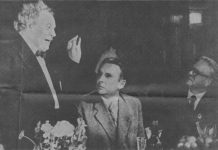
![A demonstration of workers from the Putilov plant in Petrograd (modern day St. Peterburg), Russia, during the February Revolution. The left banner reads (misspelt) "Feed [plural imperative] the children of the defenders of the motherland"; the right banner, "Increase payments to the soldiers' families - defenders of freedom and world peace". Both refer to the economic toll the First World War was having on civilian life, February 1917 (probably around March 7 [O.S. February 22]) Photo: Unknown. Public Domain.](https://socbib.dk/wp-content/uploads/2007/04/1917-februarrevolution2.1500x0-218x150.jpg)
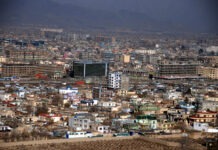
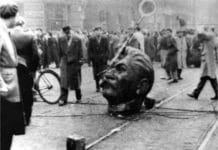

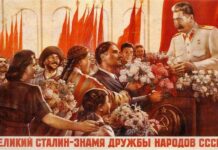











![A demonstration of workers from the Putilov plant in Petrograd (modern day St. Peterburg), Russia, during the February Revolution. The left banner reads (misspelt) "Feed [plural imperative] the children of the defenders of the motherland"; the right banner, "Increase payments to the soldiers' families - defenders of freedom and world peace". Both refer to the economic toll the First World War was having on civilian life, February 1917 (probably around March 7 [O.S. February 22]) Photo: Unknown. Public Domain.](https://socbib.dk/wp-content/uploads/2007/04/1917-februarrevolution2.1500x0-100x70.jpg)